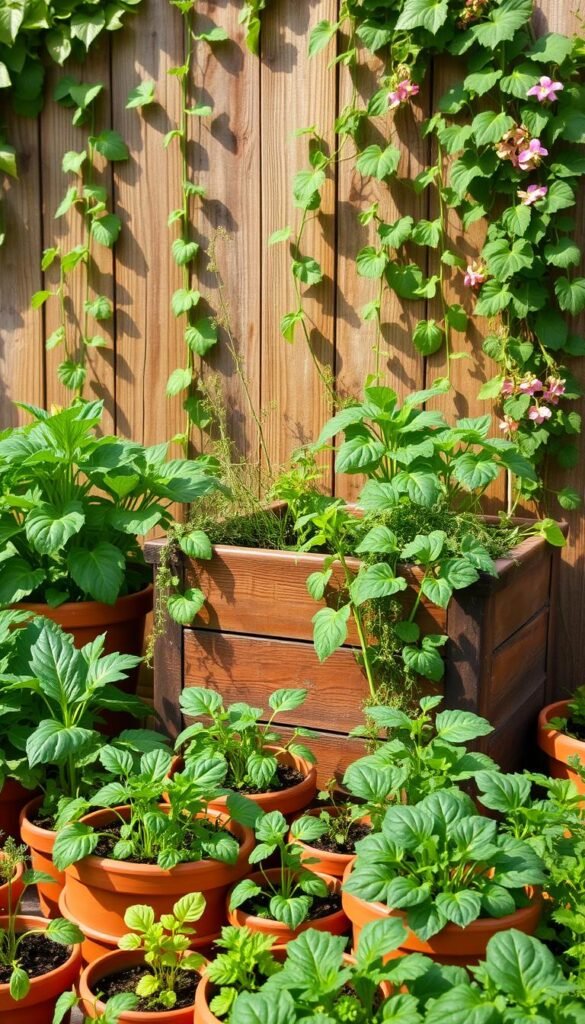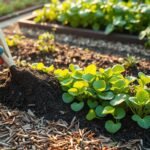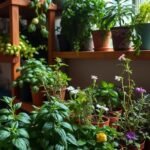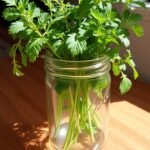Want homegrown tomatoes on your fire escape or herbs by your kitchen window? Small-space growing lets you harvest fresh flavors without a backyard. All you need is sunlight, the right setup, and a little know-how.
Your plants rely completely on what you give them. That potting mix isn’t just dirt—it’s the lifeline for roots to breathe, drink, and feast. Poor drainage or compacted blends drown delicate roots faster than you’d think.
This guide skips the guesswork. You’ll learn why lightweight, nutrient-rich blends outperform regular garden soil in confined spaces. We’ll show how to match container sizes to crop needs so zucchini thrives as happily as basil.
Ready to turn that sunny corner into a salad factory? Let’s dig into the essentials that separate struggling sprouts from overflowing harvests.
Understanding the Basics of Container Gardening
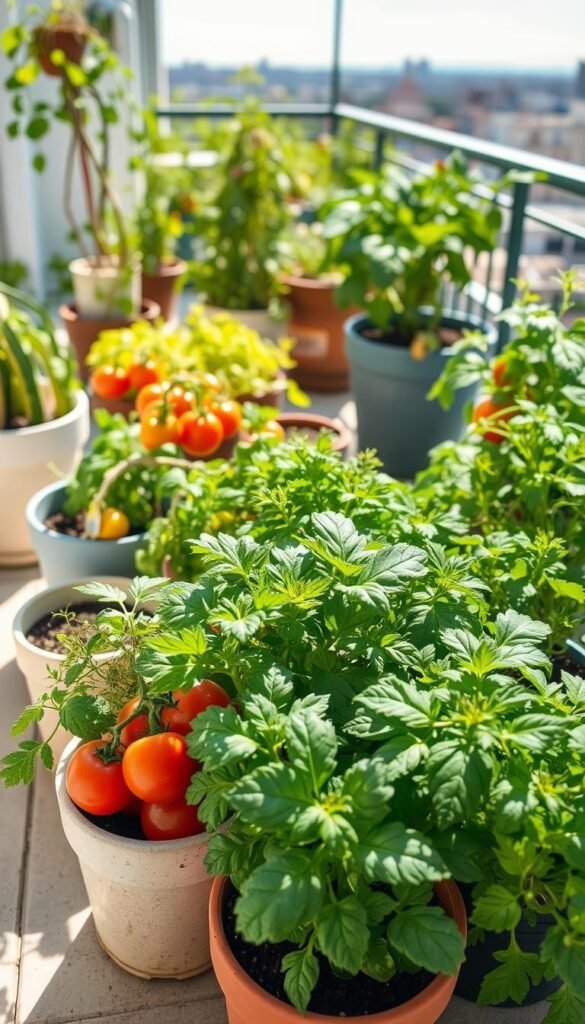
Urban living doesn’t mean sacrificing fresh greens—just rethink where you plant. This approach transforms windowsills, railings, and stairways into productive spaces. Your plants grow exactly where you need them, whether that’s beside your coffee maker for morning herb harvests or along a sunny wall for cascuing cherry tomatoes.
Benefits of Elevated Growing
You gain power over your plants’ world. Move pots to chase sunlight through the day or shield tender leaves from harsh winds. Rainy day? Just slide your peppers indoors. This mobility helps extend seasons, letting you grow heat-loving eggplants earlier and leafy greens later into fall.
Raised planters bring the garden to you. No bending or kneeling required—ideal for sore backs or wheelchair users. Mix edible and ornamental plants for displays that feed both your stomach and soul. Try pairing purple basil with red begonias or lettuce with trailing nasturtiums.
Picking Plant Homes
Your container choice impacts root health and growth. Consider these options:
| Material | Best For | Weight |
|---|---|---|
| Plastic | Balconies | Light |
| Ceramic | Decorative areas | Heavy |
| Fabric | Root crops | Medium |
Shallow pots work for herbs, while deep ones suit carrots. Always check drainage holes—roots drown in standing water. Match sizes to your space, using vertical stackers for tight corners or wide troughs for patio edges.
Selecting the Ideal Soil Mix for Healthy Growth
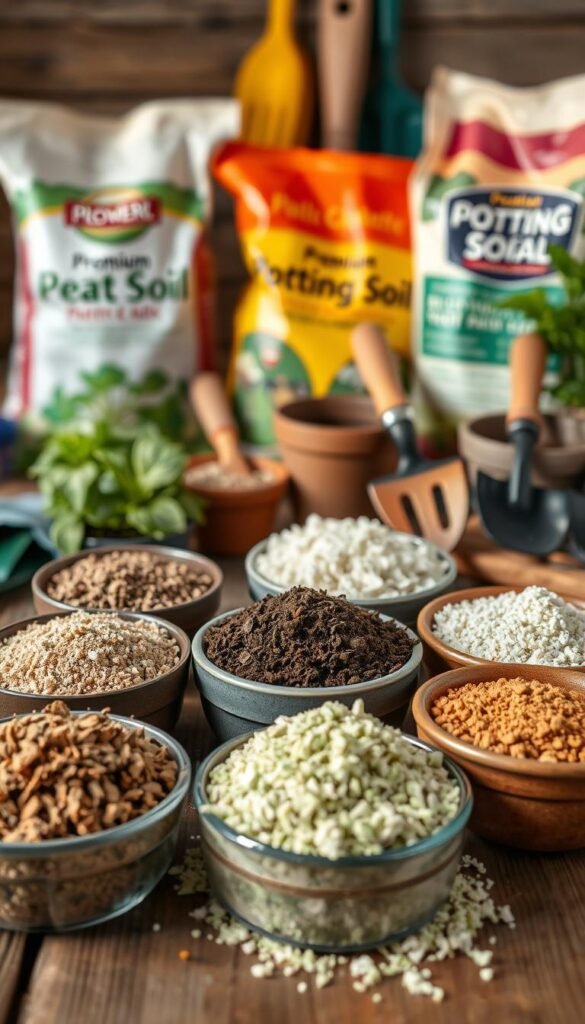
Ever wonder why plants thrive in some pots but drown in others? It’s all about what’s beneath the surface. What you fill your planters with determines whether roots gasp for air or grow strong enough to support juicy tomatoes.
Key Ingredients for Proper Drainage and Aeration
Your plants need breathing room. A great blend combines:
- Peat moss – holds water without becoming soggy
- Perlite – those white bits create air tunnels
- Compost – feeds roots slowly over time
These lightweight materials prevent compaction. Roots stay oxygenated while still sipping moisture between waterings. Bagged mixes labeled “potting soil” usually nail this balance.
Why Topsoil Is Not Suitable for Containers
That dirt from your yard? It’s a death sentence for potted plants. Topsoil:
- Hardens like concrete after watering
- Harbors weeds and harmful microbes
- Lacks the fluffy texture roots crave
Sterilized potting mixes eliminate these risks. They’re designed to stay loose and nutrient-rich in confined spaces. Your plants get clean, disease-free homes – no unwelcome guests tagging along.
Container Vegetable Garden Tips: Choosing the Right Pots and Soil Mixes
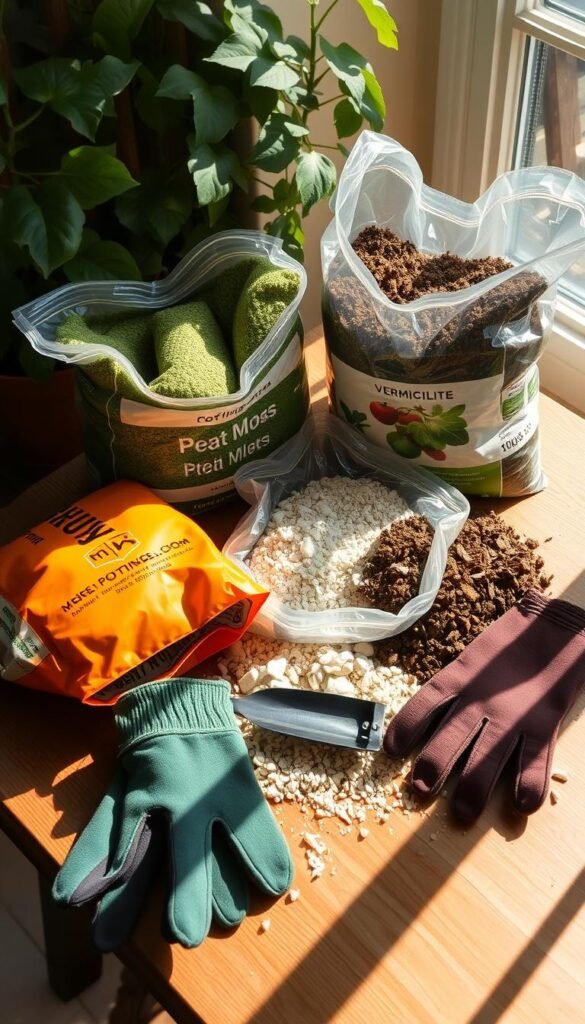
Your plants’ success starts below the surface—what you can’t see matters most. A thriving root system needs equal parts hydration, airflow, and nutrition. Get this balance right, and you’ll grow vibrant produce that tastes like summer sunshine.
Key Considerations for Soil Mix Ingredients
Peat moss acts like a sponge, holding moisture while keeping the blend light. Pair it with perlite—those tiny white pellets create air pockets so roots don’t suffocate. Add compost to feed your greens slowly, like a multivitamin for plants.
Dolomitic lime works double duty. It balances acidity and delivers calcium for strong stems. For organic growers, rock phosphate releases phosphorus over months, while blood meal gives leafy greens a nitrogen boost without harsh chemicals.
Here’s the secret ratio pros use: equal parts peat, perlite, and compost. Add amendments based on what you’re growing—more lime for tomatoes, extra greensand for potassium-loving peppers. Cheap bags from big-box stores often skimp on these components, leading to collapsed blends by midsummer.
Your mix should feel fluffy, like freshly sifted cake flour. If it clumps when squeezed, add more perlite. Quality ingredients cost more upfront but save money (and heartache) when your basil survives August heatwaves.
Crafting Your Own Homemade Potting Mix
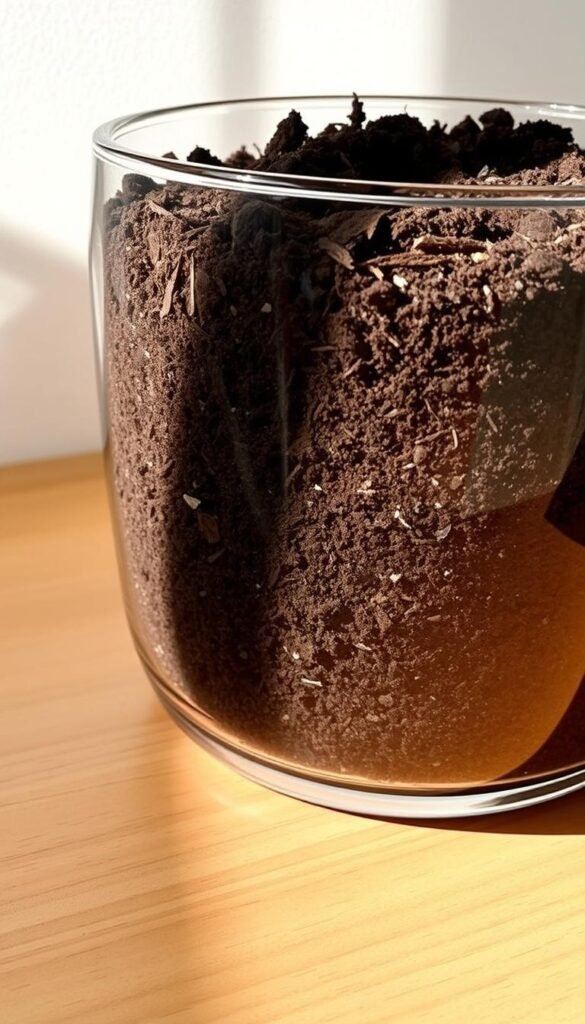
Tailored soil recipes unlock your garden’s full potential. Commercial potting soil often disappoints—many brands now use cheaper fillers that collapse by midseason. Mixing your own blend solves this while saving money.
Soil-Based vs. Soilless Showdown
Both approaches have merits. Soil-based blends combine potting mix with compost for natural nutrients. Soilless versions use peat and perlite for sterility—perfect for seed starting.
| Mix Type | Components | Benefits | Best For |
|---|---|---|---|
| Soil-Based | 1 part potting soil 1 part compost |
Slow-release nutrients Microbe-rich |
Tomatoes, peppers |
| Soilless | 2 parts peat moss 2 parts perlite |
Disease-free Lightweight |
Herbs, seedlings |
Power Up With Amendments
Add a handful of Plant-tone to every gallon of mix. This organic fertilizer feeds plants for 4 months. For heavy feeders, blend in worm castings or bone meal.
Store extra potting mix in sealed bins. You’ll have ready-to-use blends when repotting or expanding your green oasis. Adjust ratios based on crop needs—less compost for thyme, more for zucchini.
Watering Strategies and Drainage Solutions
Keeping your plants happy in pots starts with mastering their drink schedule. Unlike ground-grown crops, potted greens face faster moisture loss due to sun exposure and limited soil volume. Timing and technique make all the difference between thriving harvests and crispy leaves.
Efficient Watering Techniques for Containers
Water before breakfast. Early morning hydration lets roots drink deeply before afternoon heat. Soak until water streams from drainage holes—this ensures moisture reaches the entire root zone. Check soil daily in summer by sticking your finger an inch deep. Dry? Time for another round.
Utilizing Olla Pots to Maintain Moisture Balance
Ancient wisdom meets modern growing. Bury unglazed clay pots in your planters—they slowly seep water as soil dries. This self-regulating system cuts watering frequency by half while preventing overhydration. Perfect for vacation days or forgetful gardeners.
| Method | Frequency | Benefits | Best For |
|---|---|---|---|
| Hand Watering | Daily | Precise control | Small setups |
| Olla Pots | Weekly | Consistent moisture | Busy growers |
| Drip Systems | Automated | Time-saving | Large collections |
Ensuring Proper Drainage to Prevent Overwatering
Drowning roots is deadlier than thirst. Always use pots with multiple drainage holes. Add a gravel layer at the bottom if holes seem inadequate. For extra protection, mix perlite into your soil—it keeps the blend airy even during rainy spells.
Watch for sagging leaves or yellowing stems. These often signal waterlogged roots needing rescue. Let soil dry completely before adjusting your routine. Remember: consistent moisture beats alternating floods and droughts.
Adapting to Seasonal Changes and Container Management
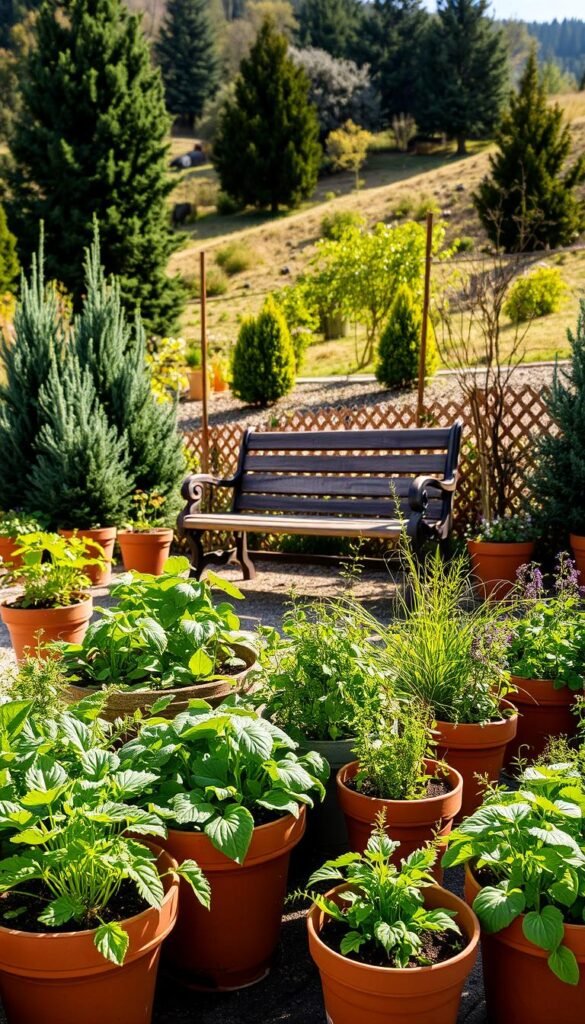
Does your harvest dwindle when temperatures swing? Smart adjustments keep plants productive through summer heat and fall chills. Seasonal shifts demand different care routines—from tweaking soil chemistry to refreshing nutrients.
Tailoring Your Soil pH for Specific Vegetables
Tomatoes and peppers crave slightly acidic conditions (6.2-6.8 pH). Test your blend with a $10 kit from the garden store. Too alkaline? Mix in sulfur. Too acidic? Add crushed eggshells. Herbs like basil thrive near neutral (7.0 pH)—sprinkle wood ash if rain washes away alkalinity.
Managing Soil Replacement and Fertilizer Schedules
Refresh potting mix every 12-24 months. EarthBox users can stretch this to many years by topping with compost between crops. For DIY planters, replace half the soil annually. Heavy feeders like tomatoes need biweekly liquid fish emulsion, while rosemary thrives on quarterly granular feeds.
| Crop | Fertilizer Type | Frequency |
|---|---|---|
| Tomatoes | Slow-release + compost tea | Every 14 days |
| Peppers | Balanced organic blend | Monthly |
| Herbs | Seaweed extract | Spring & midsummer |
Move pots to shaded areas during heatwaves. When frost threatens, wheel planters indoors overnight. Your management strategy determines whether plants survive or thrive through seasonal rollercoasters.
Wrapping Up Your Container Garden Journey
Your patio just became a powerhouse for fresh produce. With smart material choices and balanced soil blends, you’ve got everything needed to grow vibrant greens in tight spaces. Quality ingredients and proper drainage transform even a windowsill into a salad bar.
Remember: plants thrive when their roots breathe. Use fluffy mixes with perlite for airflow, and water when the top inch feels dry. Match container sizes to your crops—shallow for herbs, deep for carrots. These simple rules keep harvests coming all season.
Gardening in limited areas works well when you adapt to your plants’ needs. Rotate crops yearly to refresh nutrients, and add slow-release fertilizer during planting. Your homegrown tomatoes and peppers will taste better than anything from the store.
Now go get dirty! Whether you’re growing basil for pasta night or rainbow chard for stir-fries, your edible oasis awaits. Share extras with neighbors—nothing builds community like swapping homegrown zucchini.
